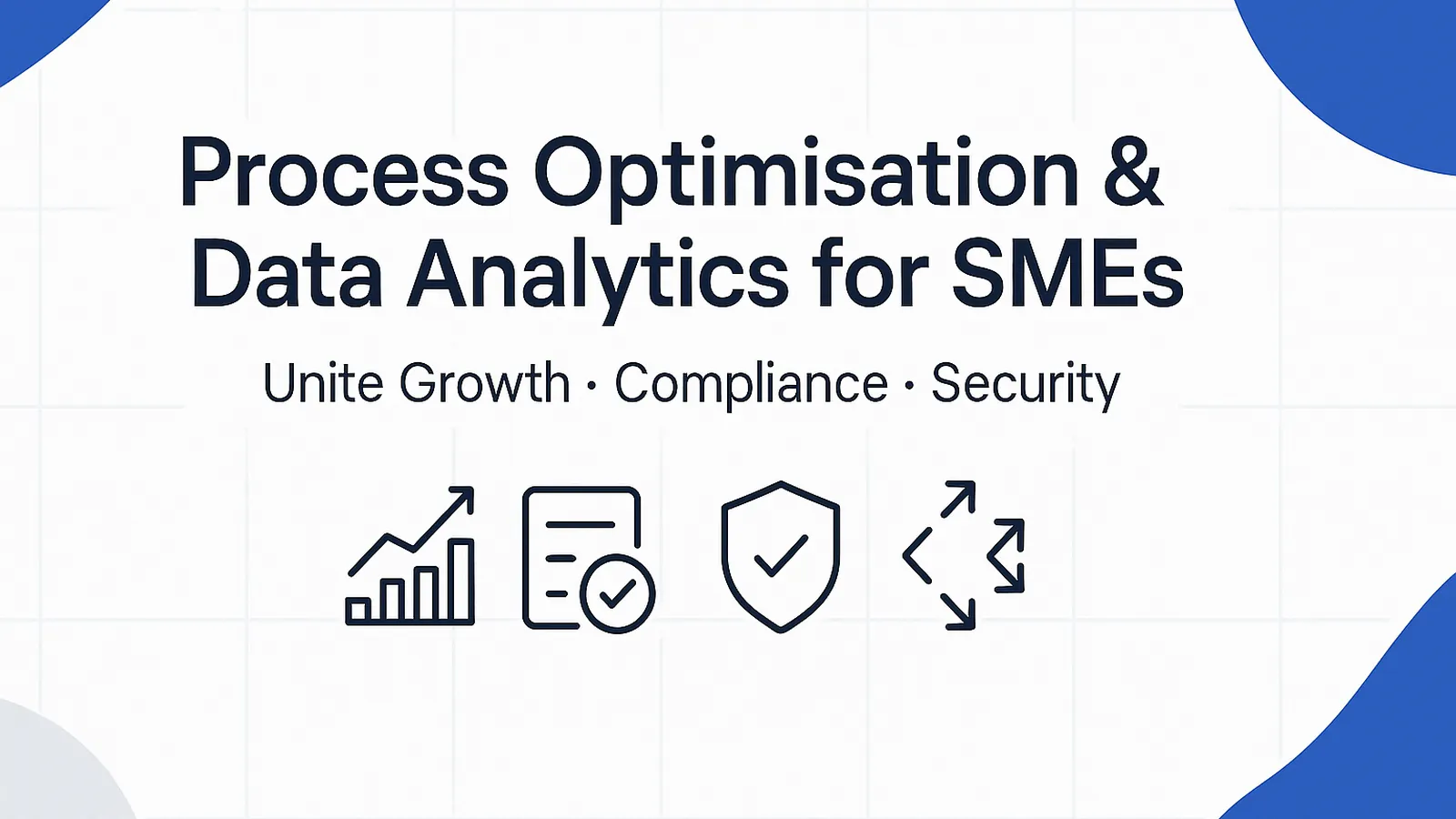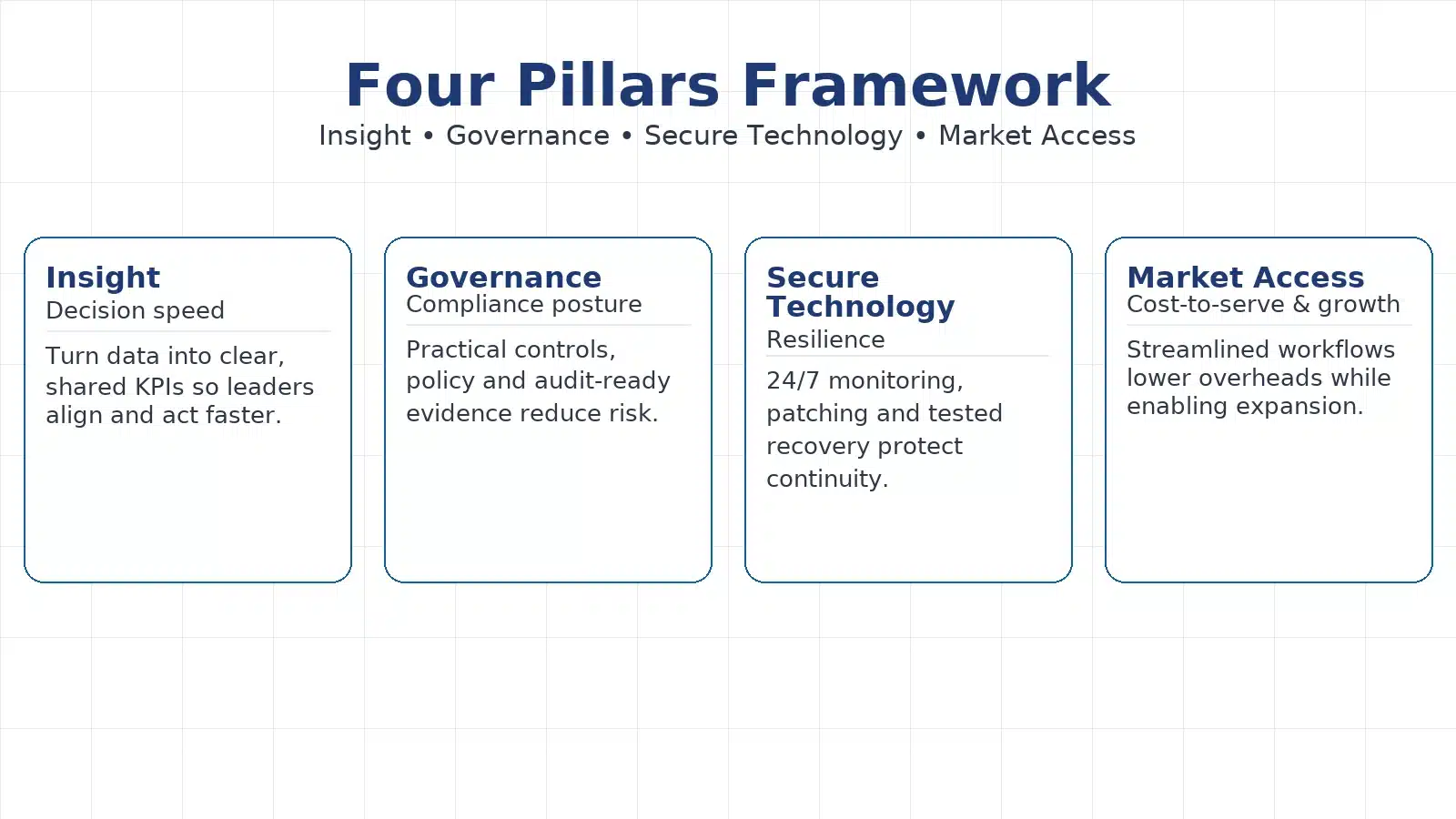
Why SMEs Must Unite Growth, Compliance, and Security Under One Framework
Process Optimisation and Data Analytics for SMEs: Uniting Growth, Compliance and Security
Why integration matters more than ever
When growth, compliance and technology run in silos, small and mid-sized businesses pay the price. Decisions slow. Costs rise. Risks creep in. If you are preparing for funding, entering a new market, or scaling operations, these cracks can turn into lost opportunities.
It does not have to be this way. With a single framework that connects process optimisation and data analytics for SMEs to governance and secure technology, you can move faster and with more confidence.
Key takeaways
-
Fragmented operations drain time, money and trust.
-
A single framework that unites data, governance and secure technology creates measurable ROI.
-
Start with short, focused sprints that deliver results in weeks, not years.
-
The goal is resilience and scale: faster decisions, lower risk, and a stronger cost-to-serve.
The real problem: silos that stall growth
Treating growth, compliance and security as separate efforts feels tidy on an org chart. In practice, it creates friction.
-
Decision latency. Teams report different numbers from different tools. Meetings multiply. Momentum fades.
-
Duplicated effort. Processes are rebuilt in parallel. Data is rekeyed across systems. Costs rise with no extra value.
-
Hidden risk. Compliance checks arrive late. Security vulnerabilities linger. Customer trust takes a hit when errors surface.
Consider customer onboarding. Sales captures data one way. Compliance requests new forms later. IT cannot easily verify identity or consent. The customer experiences delay and repetition. Internally, your teams work harder than they should, yet still lack a single source of truth.
This is not only inefficient. It is risk exposure and opportunity cost.
Why now: the window for secure growth is closing
Three shifts make integration urgent for SMEs.
-
Rising cyber risk. Skills gaps persist while attack tools improve. Unpatched systems and weak identity controls remain common.
-
Tightening regulation. Leadership accountability is increasing. Privacy, payments and sector rules demand auditable controls.
-
Underused data. Most firms sit on valuable operational and customer data yet lack the frameworks to convert it into action.
The implication is clear. Data, processes and security must operate as one system if you want to scale reliably.
The integrated answer: four pillars that work together
An effective operating model links process, data, governance and secure technology. Think of it as one framework with four pillars.
1) Insight → Decision speed
Transform complex data into clear, decision-ready intelligence. Build executive dashboards that track a handful of business-critical KPIs, not vanity metrics. When leaders see the same facts, they decide faster and align resources sooner.
2) Governance → Compliance posture
Establish practical controls, policy, documentation and audit readiness. Map responsibilities. Record approvals. Prove you do what you say you do. Governance is not red tape when it reduces rework and accelerates external approvals.
3) Secure technology → Resilience
Harden the basics. Patch continuously. Monitor around the clock. Test recovery. Align to recognised standards such as Singapore Cyber Trust Mark or ISO 27001:2022. Resilience protects revenue and reputation, which protects valuation.
4) Market access → Cost-to-serve and growth
Use process optimisation to streamline how value flows to the customer. Remove waste, shorten cycle time and make the right way the easy way. Improved cost-to-serve funds growth while better experiences lift conversion and retention.
Each pillar is useful alone. Together, they turn change into a repeatable habit.
How the journey works: from establish to scale
Integration does not mean doing everything at once. It means sequencing the right work in the correct order so each step amplifies the next.
-
Establish and protect. Put PDPA baseline governance in place, including privacy and consent management. Stabilise core IT and verify backups.
-
Diagnose and design. Map real-world processes from trigger to outcome. Define KPIs that reflect value to the customer and value to the business. Design a lightweight analytics framework to surface these signals.
-
Enable and harden. Deploy managed IT, improve identity and access, automate patching, and implement monitoring. Close high-risk gaps first.
-
Scale and finance. Use clean data and precise controls to support tenders, partnerships, market entry, or capital raising. Create board-ready packs that show operational readiness and measurable impact.
This sequence locks in stability before adding complexity. That is how you scale without chaos.
What process optimisation looks like
Map what happens. Walk the process. Sit with the people who run it. Sample actual cases, not ideal templates.
Remove waste and ambiguity. Locate handoffs, rework and decisions without clear owners. Standardise the minimum set of paths that cover most cases. Keep exceptions separate so they do not pollute the happy path.
Write simple SOPs. Plain language. One page, if possible. Screenshots were useful. Everyone should be able to understand and follow them.
Measure outcomes, not activity. Count cycle time, error rate and first-time-right, not only tickets closed. Review weekly. Fix the most significant constraint first.
Automate only after stabilising. Automation accelerates both good and bad processes. Stabilise first, then automate the stable parts.
This discipline frees capacity, reduces frustration and lifts quality. It also makes analytics cleaner because consistent steps produce the data.
Data analytics for SMEs: from reporting to results
Analytics earns its keep when it answers three questions.
-
What is happening? Track the few KPIs that matter.
-
Why is it happening? Segment by product, customer type or channel. Trace back to the step that predicts failure or delay.
-
What should we do next? Turn insight into action. Change a rule. Adjust a threshold. Reorder a queue. Test the effect.
Examples that deliver value quickly:
-
Predict late payments and adapt credit terms or reminders.
-
Flag low-margin products or services that dilute profitability.
-
Expose underused capacity and rebalance workloads.
-
Link lead quality to conversion and onboarding effort to refine spend.
When analytics sits on top of stable processes and trusted definitions, it becomes a growth lever rather than a reporting chore.
Fast-track to impact: three practical sprints
SMEs rarely need multi-year programmes. They need visible wins in 6 to 12 weeks that build momentum.
Sprint 1: Compliance and data readiness (weeks 0–6)
-
Review legal entities and governance.
-
Implement a privacy baseline with clear consent capture.
-
Map one or two critical processes and recommend changes.
Outcome: A secure compliance foundation and a clear operational baseline.
Sprint 2: Insight accelerator (weeks 6–12)
-
Build a lightweight operational data pipeline.
-
Implement an executive dashboard for agreed KPIs.
-
Produce a simple SOP pack for the mapped processes.
Outcome: Actionable insight and measurable efficiency gains.
Sprint 3: Secure operations managed service (ongoing)
-
Monitor infrastructure and security continuously.
-
Automate patching and maintenance.
-
Test recovery and scan for vulnerabilities on a regular cadence.
Outcome: Continuous resilience and fewer surprises.
A practical example: scaling without chaos
A mid-sized logistics firm wanted regional expansion but wrestled with spreadsheets, manual checks and inconsistent data definitions. The risk was simple. Scaling would multiply the noise.
-
Approach. Over six weeks, the team mapped order-to-cash, created one customer data standard, introduced SOPs, and built a KPI dashboard for cycle time, error rate, and first-time-right. In parallel, identity controls and patch management were improved.
-
Result. Processing time fell noticeably. Audit preparation became quicker because approvals and evidence were captured in the flow. Leaders had a shared view of readiness, which reduced debate and sped up decisions.
The lesson is not that dashboards fix everything. The lesson is that processes, data and security must move together so improvements stick.
Implementation roadmap: start small, move fast
-
Choose one high-leverage process. Fewer handoffs. Clear value. Visible pain today.
-
Agree on the outcomes and KPIs. Define success in business terms. For example, reduce the onboarding cycle time by 30 per cent and the error rate by half.
-
Map, simplify and standardise. Capture the real flow. Strip non-value steps. Write simple SOPs.
-
Stabilise the tech. Patch, back up, and lock down identity. Remove shared accounts.
-
Build the first dashboard. Only the agreed KPIs. Nothing else.
-
Run a 30-day improvement cycle. Measure weekly. Fix the most significant constraint. Publish results.
-
Decide on automation only after the process behaves consistently.
-
Extend to the following process. Reuse patterns. Keep the cadence.
This rhythm is how you change culture without a change-management programme.
Governance without the bureaucracy
Good governance is practical. It clarifies ownership and reduces fear. Start with:
-
RACI for key processes. Who is responsible, accountable, consulted and informed?
-
Decision records. Short notes that show what was decided and why.
-
A policy that people can read. One page. No jargon. Link to the SOP, not a maze of PDFs.
-
Evidence by default. Capture approvals in the tools you use, not in scattered email threads.
You will find that external stakeholders respond better when you can show simple control that works.
Secure technology: the few basics that matter most
-
Identity first. Named accounts, multi-factor authentication, and least privilege.
-
Patch relentlessly. Automate updates where possible. Track exceptions.
-
Back up what matters and test recovery. A backup you cannot restore is not a backup.
-
Monitor continuously. Know what is normal so you can spot what is not.
-
Harden remote access and endpoints. Most incidents start at the edge.
Security is not a product. It is a discipline that protects your ability to trade.
Metrics that prove progress
Choose a small set of measures that leaders will review every week.
-
Decision latency. Time from data refresh to decision recorded.
-
Cycle time. Start to finish for the process you are improving.
-
First-time-right. Percentage completed without rework.
-
Cost-to-serve. The effort and spending required per successful outcome.
-
Compliance readiness. Gaps closed and evidence available.
-
Security posture. Critical patches outstanding and recovery test status.
Post these on one page. Celebrate improvements. Investigate regressions. Keep the list stable so people can learn.
Risks and how to avoid them
-
Automating a broken process. Stabilise first, then automate.
-
Dashboard overload. More charts do not equal more control. Keep to the vital few.
-
Policy theatre. Paper without behaviour creates false confidence. Audit what people do.
-
One-off projects. Without cadence, gains fade. Keep a monthly improvement cycle.
Anticipating these pitfalls is part of the value of an integrated approach.
Frequently asked questions
Is this too heavy for a small team?
No. Start with one process and one dashboard. The point is to reduce work, not add it.
Do we need new tools?
Often, you can start with what you have. Consistent definitions and SOPs deliver value before any licence spend.
How fast will we see results?
Many SMEs see visible gains within the first 6 to 12 weeks when they focus on a single process and review progress weekly.
What about certification?
If your industry requires it, the same building blocks apply. Stable processes, clear roles, evidence by default, and tested controls.
Outcomes that matter to leaders
When you connect process optimisation and data analytics for SMEs with governance and secure technology, the impact shows up quickly.
-
Faster decisions because everyone trusts the exact numbers.
-
Lower regulatory exposure through practical governance.
-
Resilience from tested security and recovery.
-
Profitable growth by improving cost-to-serve and customer experience.
This is not a transformation for its own sake. It is the operating model for the next phase of your business.
Final thought: you do not walk alone
Scaling can feel like a lonely path through compliance complexity, data noise and cyber risk. You do not have to face it on your own. With the right partner beside you, you never walk alone on the journey to secure, sustainable growth.
Ready to begin? Book your Leadership Alignment Workshop and let us map the first process together!






